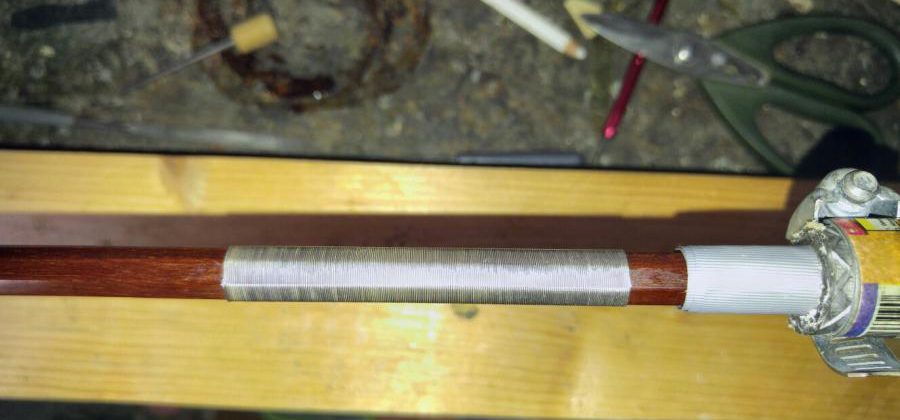What is the lapping on a bow, and what is its purpose?
I know, lapping sounds like something that a runner does in a race, but it is also the name given for the wrapping of usually either some kind of metal, plastic, bone, wood, or silk around the shaft of the bow, starting just after the frog. Traditionally, the lapping will start, just after the most forward position of the frog, and continue for three inches up the stick. While the lapping should continue under the grip of the bow, at times, some bow luthiers will save some time, and silver, by stopping the lapping at the point at which the grip starts on the bow. Unfortunately, as a result one of the purposes for the lapping is negated, which is to protect the wood of the bow from being damaged when the grip is worn through. Lapping does, as well, help to balance the bow, by carefully adding weight (about 5-8 grams) to the frog end of the stick, and putting more weight over the balance point of the bow. Balance of the bow is a VERY serious consideration when choosing a bow, or having a bow restored, as the incorrect balance of the bow can lead to some serious overuse physical ailments in the right arm, wrist, and fingers.
There are several different materials that can be used as lapping materials on the bow: metal wire (gold, silver, and nickel), whale bone (obviously, in the modern era, the use of whale parts is banned, and has been replaced by plastic, and in some rare cases bone) and ebony ribbons that are alternated to give a black and white effect, and colored silks that can be woven into some very beautiful and intricate patterns, giving the bow an incredibly unique look.
In my shop, I regularly stock three types of silver wire for the customer to choose: fine silver, argentium, and nickel. Fine silver, is .999 pure silver, and has an incredible almost white luster to its shine when highly polished, but because of the high silver content, it does require regular polishing (rub it with a dry, soft cloth), to maintain its luster. Argentium sterling silver, is an alloy, containing 93.5% silver, mixed with copper (and what makes it unique from regular sterling silver), the metalloid germanium. I stock argentium over regular sterling for a couple of reasons: it actually contains a higher amount of silver (sterling contains 92.5% silver vs 93.5% for argentium), but more importantly, it does not tarnish nearly as quickly as sterling. This is why this silver is very popular in jewelry making, as it maintains its luster for a long period of time without any maintenance. While it does have an incredible shine, it is not quite as white as fine silver, but it will maintain its beauty with very little work. Nickel silver, is not actually silver, but the silver colored element nickel, which has been laid over a copper wire core. It has the least luster of any of the silvers, and the copper core will start to show where the acids from sweat have come into regular contact with the lapping. While it can be shined, eventually, the nickel will wear off, and the copper core to the wire will show. It is a functional lapping, that will protect the wood from grip wear, and last a long time, but will add the least luster to your bow.
Whale bone lapping, as I described earlier, are alternating bands of black and white ribbons, culminating with several wraps of only black as a tie-off, giving a band of black at the tip end of the lapping. This is a very traditional lapping, that was used on bows for a very long time, but cannot truly be replicated without the use of actual whale bone. For me, most replacement materials, do not cut the muster, and look like what they are: plastic. It is a very functional lapping, that will last an incredibly long time, will offer a very high-degree of protection for your bow under the grip, and requires very little maintenance.
Whatever lapping you may have, make sure that it stays in good condition, and is helping to add functionality and beauty to your bow. If you should find your bow needs help with its lapping, I think that you would be pleasantly surprised by how affordable it is to have real silver put onto your bow, which in-turn, will add both an incredible amount of both beauty, and value to your precious investment.

